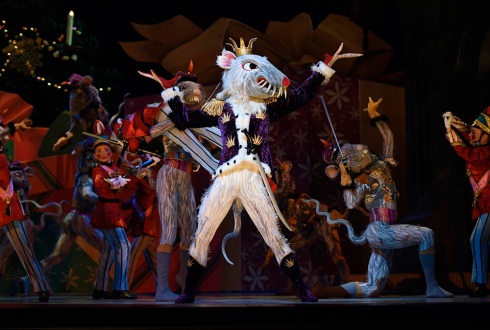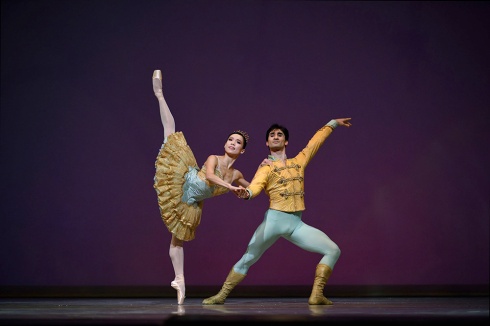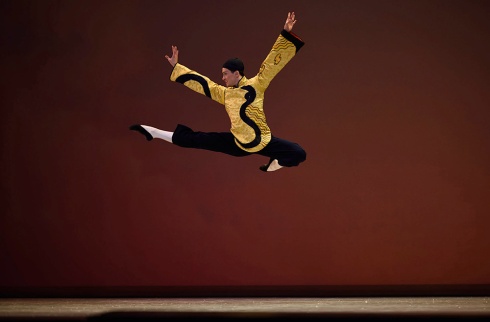In this third San Francisco production of Petyr Ilyich Tchaikovsky’s commission for Marius Petipa and Lev Ivanov (Willam Christensen’s ground–breaking undertaking and brother Lew’s the second with at least two different productions), Helgi Tomasson celebrated the city’s emergence from the 1906 earthquake and fire by aligning it to the 1915 Panama-Pacific Exposition; Michael Yeargen took his clue from images of the 100th year before in slides, Act I’s setting and hints of the Conservatory of Flowers, supported by James F. Ingalls’ lighting. Martin Pakledinaz designed the fetching gowns of the period as well as the traditional and pastiche costumes for Act II. The results congratulate San Franciscans. From the cheerful opening pandemonium sounds December 16 and the December 18 matinee, the seasonal tradition is a winner all the way. The sound pitch opening night was up there with the screams of a basketball game, while volunteers carefully herded toddlers and grammar school attendees for their pictures with a French soloist (the flute soloist for more traditional viewers) and the Mouse King, and off the other side of one of the crimson-carpeted entrances to orchestra seating. Most girls wore aspirational net tutus with frequent rhinestone tiaras. The mother of one girl near me said her chestnut-haired daughter was studying karate and acrobats.
Opening night Val Caniparoli was his genial self, if somewhat perfunctory. Katita Waldo gave us a welcoming Mme Stahlbaum while Ruben Martin Cintus exuded the pleasant organizing half.. Two youngsters, Alexander Renoff-Olson and Kristi DeCaminada made a convincing go as the grandparents. Francisco Mungamba’s displayed flexibility in yellow tights and bobbing trim; Lauren Parrott was mercifully brunette after the memorable tawny blonde of Clara Blanco; Wei Wang jumped energetically as the toy Nutcracker.
One of the production’s charms is the transformation scene, and although the sleepy gestures of Clara’s (Sienna Clark) seemed perfunctory if on time to the music, the enlarging furnishing along with the tree are just right as is the appearance of the Nutcracker Prince in the handsome personage of Davit Kerapetyan. Gaetano Amico was the nasty Mouse King, a role everyone loves to hate and the interpreter tries to make the most of in his brief allotted phrases.

San Francisco Ballet in Tomasson’s Nutcracker. (© Erik Tomasson)
Vanessa Zahorian served as a gracious Sugar Plum Fairy with Frances Chung as the grownup Clara, following the Snow Scene with Jennifer Stahl and Luke Ingham as the reigning monarchs of a blizzard almost obscuring the figures midway and towards the end. Why they dancers have to navigate a storm is beyond me. Flurries should be sufficient. The same threatened obliteration was accorded Koto Ishihara and Joseph Walsh December 18.

Frances Chung and Davit Karapetyan in Tomasson’s Nutcracker. (© Erik Tomasson)
Distinguishing themselves in the Chinese and Russian were Lonnie Weeks and Esteban Hernandez. The trio bursting from the Faberge-inspired eggs is invariably a treat to be followed by Anatole Vilzak’s variation for the three dancers. It’s one of the supreme relics of the earlier production.

Lonnie Weeks in Tomasson’s Nutcracker. (© Erik Tomasson)
I saw a second performance, the December 18 matinee to see what Pascal Molat did with Drosselmeyer. I didn’t expect Sancho Panza, of course, but he is just such a wizard with character parts. Of course he was wonderful. His hands were invariably seeking the edges and the corners of what he was assigned, finishing his work before donning his coat, the manner in which he tied the pouch for the clock, his gallantry with the flower seller on the street. His semi-crouching position when levitating the cane was like someone in a contest; I felt an unusual touch in his consoling Fritz at not getting the nutcracker, topped only by the bow with which he tied his handkerchief on the wounded wooden doll. Throughout the scene this Drosselmeyer was intimately attuned to youngsters, at one with them as well as a distinguished, eccentric clock maker. His wizardry with the transformation scene, reassurance to Clara and continued guidance through Act II was simply de rigeur. One can relax with an “ah” watching him, a total treat.
Jeffrey Lyons and Amy Yuki made a jovial and gracious set of Stahlbaums while Val Caniparoli joined Anita Paciotti in the grandparental roles.
Here Esteban Hernandez as the toy Nutcracker bounded electrically from the box. Blake Kessler was the yellow Harlequin and Jahna Frantziskonis, coming to the company from Pacific Northwest Ballet, was the porcelain pink doll.
I noticed in some principals’ tutus a broad, slightly floppy over skirt, like an expansive flower; instead of gradated layers of ruffles,the tutu cuts to the underpinning exposing upper tights and pants when lifted by a partner. What seemed to be a charming floral bouquet, suddenly your eyes were directed, minus smaller petals, to stamens and pistils.
Doris Andre served as The Sugar Plum Fairy regally. I did not notice it much before this season and it may reflect some tweaking, but the Sugar Plum Fairy summoned her waltzing flowers as well as the busy little lady bug, moths and butterflies to hear the tale of the Nutcracker Prince’s battle with the Mouse King. It brought a warmth to the undertaking, a winning witnessing to the otherwise austere evocation of the Conservatory of Flowers.
Normally the French variation, usually belonging to a trio of Dresden Shepherdess but here candy-caned striped can can dancers, appeals to me not at all. In the December 18 matinee, however, I noticed some nice phrasing with adroit finishing emphasis by Miranda Silveira.
Carlo di Lano made his debut in this production of the holiday staple with Matilde Froustey as his adult Clara. What a marvelous pair they were, both in looks and European ambiance. When the Nutcracker’s mask was lifted, di Lano’s breath animated his port de bras: liberation! This sensibility pervaded every motion, making the most logical, the most spectacular special.
